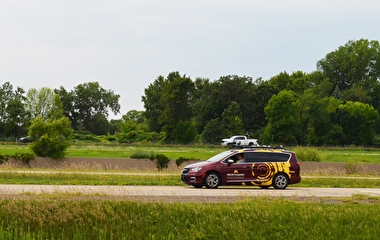CTS has secured funding to begin assembling a connected and automated vehicle (CAV) ecosystem for use in research, education, and engagement. The funding allows for the purchase of a highway-speed automated vehicle, the lease of a second highway-speed vehicle, and the lease of a shuttle-type transit vehicle.
The funding, from 13 partners, includes a major contribution from the U’s Office of the Vice President for Research. “The investment builds on researchers’ substantial body of work in this critical field and lays the groundwork for the University of Minnesota to become a national leader,” says Chris Cramer, the U’s vice president for research. “Moreover, the opportunity to partner with key Minnesota industries that are also investing in this technology has the potential to make us a true innovation leader, positively impacting Minnesota’s economy.”
While many prior efforts to create CAV research centers at different universities have focused exclusively on technical aspects, CTS will leverage the University’s prior work in vehicle automation to answer the next generation of both technical and societal questions. Since 2012, 25 projects related to connected and automated vehicles have been conducted by 30 researchers at the University of Minnesota, with a total value of $6.4 million.
CTS is currently working with stakeholders to develop a strategic research plan. The plan builds on what was learned from a series of focus groups and interviews about University researchers’ interests, and it aligns those interests with external market dynamics. The following research categories are emerging as potential niche areas where the University of Minnesota’s CAV research program would be unique:
- CAVs and vulnerable road users: This includes building an understanding of how CAVs will detect and identify vulnerable road users such as bicyclists, pedestrians, and riders of micromobility vehicles (e.g., electric scooters and e-bikes). Additionally, research will explore how vulnerable road users will interact with CAVs, and how to design CAVs to provide a safe and enjoyable experience for all road users.
- CAVs and variable weather conditions: Many CAV research deployments have been conducted in areas with reliable weather conditions. Coping with extreme weather will be critical for taking CAVs from the lab into the city and an important first step in developing CAVs that can be deployed at scale. Research includes understanding how to sense obstacles in heavy rain or snow and how to control vehicles in low-traction road conditions.
- Public perception and trust of CAVs: For full integration into society, humans must trust the safety of the CAVs being designed. This focus area emphasizes the importance of understanding how to build trust in CAVs and how to design CAVs that humans can trust.
The CAV program will also include an education and workforce development component. Minnesota companies are at the frontier of CAV-related industries and are looking for creative ideas and human talent.
“By bringing multiple departments, units, and colleges together, U of M students will be able to learn and excel in various areas of autonomous vehicles,” says Laurie McGinnis, CTS director. “This will benefit the University, the state, and businesses.” Statewide engagement and outreach will also be offered through the CAV program.
CTS is currently exploring arrangements with private- and public-sector partners. This includes scoping the final technical specifications for the U’s highway-speed test vehicle and investigating vendor options for the lease of a shuttle-type transit vehicle.



